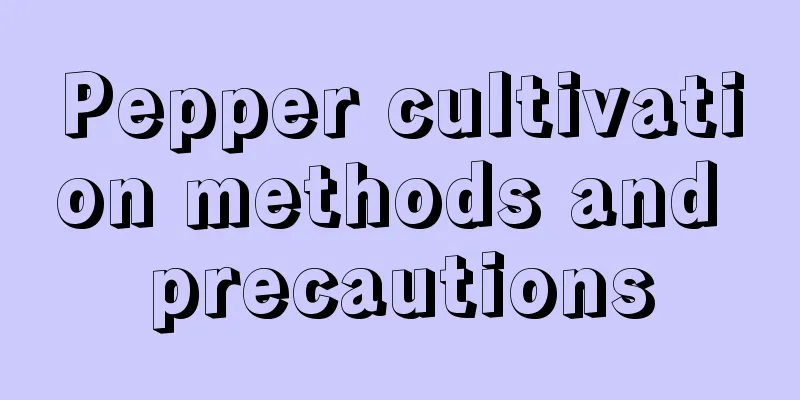Pepper cultivation methods and precautions

|
Pepper is a common vegetable , rich in vitamins and minerals. It is an indispensable ingredient in our daily diet and an important condiment . It has many varieties and colors, and some can also be used as ornamental plants. Let’s talk about the cultivation methods and precautions of pepper. 1. Choose the right variety According to your purpose and preference, choose the pepper variety that suits you, such as sweet pepper, pointed pepper, round pepper, lantern pepper, etc. Different varieties have different growth habits, disease resistance and yield, as well as different tastes and spiciness. 2. Prepare seeds and soil Choose pepper seeds that are fresh, strong, and free of pests and diseases. You can soak them in warm water for a few hours, then wrap them in a wet cloth and place them in a warm and ventilated place to germinate. The soil should be fertile, loose and well-drained. You can add some organic fertilizer and decomposed farm manure to improve the soil's fertility and air permeability. 3. Seeding and planting Spread the germinated seeds evenly on the seedbed, cover with a layer of fine soil, keep the soil moist and avoid direct sunlight. When the seedlings are 5-6 cm tall, they can be transplanted. When planting, pay attention to the row spacing and plant spacing, which are generally 40-50 cm and 20-30 cm, to avoid being too dense or too sparse. After planting, water thoroughly to promote root growth. 4. Moisture Management Peppers require a lot of water, but overwatering should be avoided. Generally speaking, watering 1-2 times a week is sufficient. When watering, be careful not to get water on the leaves to avoid causing diseases. At the same time, avoid allowing water to accumulate in the soil, which can cause root rot. 5. Pruning management Peppers can be pruned for a short period of time to promote branching growth and increase yield. When the pepper plant grows to a certain height, you can trim the top of the trunk to promote branch growth. 6. Harvest Peppers must be pollinated in time after flowering. You can gently shake the branches with your hands or brush the stamens with a brush. After the peppers bear fruit, you should harvest them according to your needs. Generally, you can harvest them before or after the fruits are ripe, but be careful not to damage the fruits and the plants. That’s it |
<<: How to care for fresh cut flowers of Cineraria, what to do if they wilt
>>: Precautions for transplanting the fortune tree and how to water it after transplanting
Recommend
Where is the best place to grow sugar apple?
Custard apple planting area Generally, sugar appl...
How to Plant Coriander Seeds
1. Planting time Planting is usually done in autu...
Can activated carbon be used as fertilizer?
Activated carbon as fertilizer Activated carbon i...
How to propagate random grass
Propagation of Random Grass by Division Breeding ...
Can the plant "Smooth Sailing" survive if its leaves are drooping? How can I save the plant if its leaves are drooping and becoming soft?
Can the smooth sailing plant survive if its leave...
The difference between Chunlan and Huilan
Petiole ring The petiole ring is the point that d...
How to save dragon blood tree root rot
1. Rescue Methods 1. After discovering that the d...
Does Panax notoginseng prefer yin or yang?
Does Panax notoginseng prefer yin or yang? Panax ...
Cultivation methods and precautions of coleus
Soil requirements Friends who grow flowers know t...
Where do flower seeds come from?
How do flower seeds come from? The pistil of the ...
Should I use a large or small pot for myrobalan?
Should I use a large or small pot for myrobalan? ...
How to plant edible lilies and what season is suitable for planting?
Edible lily is a medicinal material and an emergi...
Is wolfsbane poisonous?
1. The origin of the name of wolfsbane Wolfsbane ...
How to deal with ants in the soil for growing flowers (effective methods to kill ants in the soil of flower pots)
When growing flowers at home, I always worry abou...
Cultivation methods and precautions of red-backed peperomia
Red-backed peperomia is a kind of succulent grass...









